Mysterious Cases of Living Fossils, Suspended Animation, and Hibernation
We all know that fossils, by their very nature, are dead. Of course, nothing can survive the conditions of pressure, depth and time required to petrify wood, see saplings mature into massive trees, transmogrify vegetation into coal or metamorphose mud into solid rock. Still, living creatures seemingly from remotest antiquity keep turning up encased in stone from far beneath Earth's surface, embedded inside solid tree trunks and in other situations defying both reason and the gospel of the Great God Science.
Living Fossils Story #1: Ancient Wormhole Mine
One such case occurred April 22, 1881, when miner Joe Molino was working deep in the Wide West Mine outside Ruby Hill, Nevada. When he wedged loose a protruding hunk of stone from the tunnel wall it landed on his foot. Enraged, he grabbed a sledgehammer and smashed it to bits. Molino was stunned to see his hammer blow had exposed a baseball-sized cavity in the rock. It was half full of motionless white worms.
As a crowd of quizzical miners gathered to view the unusual artifacts the worms began to move. Within an hour they were crawling around on the floor of the tunnel
- Long Frozen Organisms in the Arctic Awakened, Hinting at Life on Other Planets
- Cryogenic Breakthrough: Worms Frozen in Permafrost for 42,000 Years Have Been Resuscitated!
Mine operators sent the worms (whose species apparently was never determined) and their solid stone sarcophagus to the U.S. Bureau of Mines. Several weeks later the bureau sent the mine operators a letter declaring they must have been mistaken. Since it clearly is impossible for creatures to have survived under the circumstances described, as far as the bureau was concerned there was no way the incident could have happened.
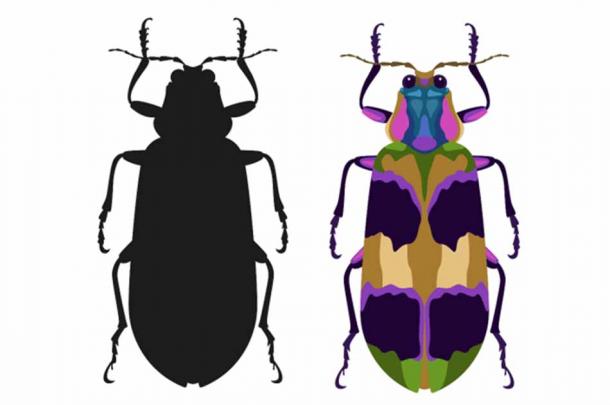
In 1892 an ore nugget found in an Arizona mine was found to contain a dead beetle from which emerged a live beetle: is that a living fossil or what? ( wectorcolor / Adobe Stock)
Living Fossils Story #2: Beetle Awe
Yet more scientific mystery was brewing in the American West when, sometime in 1892, a large beetle was found encased in a chunk of iron ore in the Longfellow Mine outside Clifton, Arizona. The ore nugget and its dead inhabitant were turned over to El Paso geologist Z. T. White, who placed the insect in a specimen case. Several days later he was shocked to see the creature move. Watching through a magnifying glass White saw a small beetle emerge from the body of the larger, dead one. He placed the small beetle in a jar where it lived for several months. When it died, he presented it, the larger beetle and the lump of ore to the Smithsonian Institution , where they may remain to this day.
Living Fossils Story #3: A Load of Bullfrog
Since the vast majority of fossils are buried, it is predictable that mines are the main source of mysterious zoological artifacts. In 1873, miners at the Black Diamond Coal Mine outside San Francisco found a large frog encased in limestone.
This common (but venerable) bullfrog was apparently blind, and able to slowly move just one leg. After several hours on the surface, it died. The frog and its entombing stone were given to the San Francisco Academy of Sciences, where its survival of what would seem an impossible stretch of time continues to defy understanding.
Yet not all living fossils are found in stone or ore.
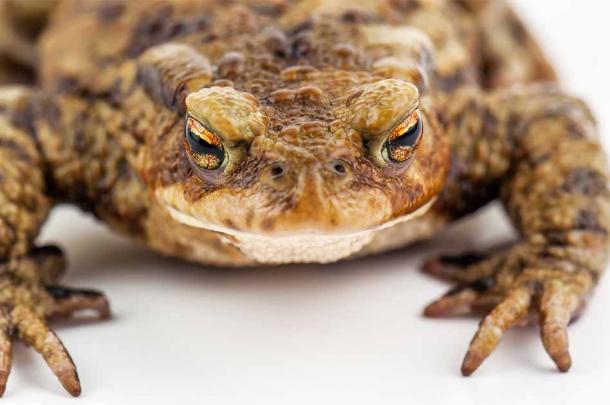
Once in 1893 in Ontario, Canada a live toad emerged from deep inside a tree trunk! ( Volodymyr Shevchuk / Adobe Stock)
Living Fossils Story #4: Would you believe it?
In October 1893 workmen at the Brown and Hall Sawmill in Ontario, Canada were using a circular saw to cut a large tree trunk into planks when the blade sliced through a cavity containing (and almost cut in two) a live toad imprisoned squarely in the middle of the tree trunk. The tree was about 200 years old, and the spherical, perfectly smooth hole in which the amphibian was entombed was about 60 feet (18 meters) above the ground. The toad tumbled from its wooden prison and hopped away, seemingly none the worse for its long confinement.
Another report of a live toad in a hole comes from England. In 1829 huge granite blocks that had formed a submerged footing under the docks of Liverpool's George's Basin were being cut into small chunks to be made into steps. During one of the cuts, the stone saw revealed a little hole in the middle of a block, and a toad within it.
- The Immense Collection of Strange Acambaro Figurines: Evidence of Dinosaurs Living Among Us?
- 3,300 Years Ago Ancient Egyptians Collected and Revered Ancient Fossils Now Known as the ‘Black Bones of Set’
Workers gently enlarged the hole to free its occupant, and the amphibian made several futile attempts to get to its feet. Several hours later, after trying one last time to assume its normal crouching position, the toad sank to the pavement and died. Several scientists who later examined the small corpse confessed they were at a loss to explain how the animal could have been found alive under such airless, foodless and waterless conditions. One of these learned men took the dead animal home with him, and it was never seen again. It was not the first or last impossible fossil yielded by Britain
Living Fossils Story #5: Newt News
In 1818 professional geologist Dr. E.D. Clark, who taught at Caius College in Cambridge, Scotland, was present at the digging of a pit on a friend's property when the workmen hit a layer of animated fossils. As one of the workers was breaking up a large chunk of chalk stone into smaller pieces so they could be removed from the hole he found three newts embedded in the rock. Clarke placed them in the bright sunlight and was stupefied when they began to move. Two of them died later in the day, and for years he exhibited them to his students during his lectures on prehistory. He placed the third newt in a nearby brook, and it "skipped and twisted about as though it had never been torpid," and escaped, he later said. Clarke was never able to identify the species to which the newts belonged.
Upon Clarke's retirement he donated the preserved newts to the university's biology department, where, for decades, other professors displayed them during lectures. During the chaos of the 1940 Nazi bombing blitz these pickled specimens turned up missing. Unless they were blown to atoms by a Luftwaffe bomb, they may remain somewhere within Cambridge University, forgotten and still unexplained.
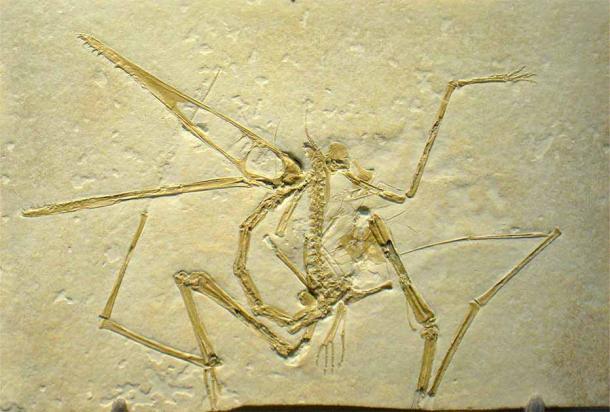
This is a fossil of a flying dinosaur, a Pterodactylus antiquus, and a close cousin of this species was apparently still alive in France in the 1850s according to newspaper reports at the time. (Daderot / Public domain )
Living Fossils Story #6: Shades of the Jurassic
The most incredible find of a living fossil is that reported by the Illustrated London Times of February 9, 1856. The incident occurred in France during the construction of a railway tunnel between the towns of Nancy and St. Dizier. According to the article, workers were breaking up a huge boulder when a goose-sized monster staggered from a freshly exposed cavity and screeched hoarsely before falling dead. It had a long beak, sharp teeth, four legs joined by membranes, and feet with long hooked talons. Its flesh was oily and glossy black.
The mysterious carcass was taken to a paleontologist who instantly recognized the animal as a Pterodactylus anas, a denizen of the Jurassic Period , which ended 135 million years ago. There is no record of whether the body was preserved and still exists.
Possibilities
Certain animals' ability to live long stretches without sustenance is possible via hibernation to escape the lean, hostile conditions of winter. Because their metabolisms are conditioned to arouse them upon the advent of the warmth and renewed food supplies of springtime, they are seldom in suspended animation for more than four or five months. What might happen if spring never arrived? What if their hibernation dens were to be buried by glaciers and/or metamorphose into rock?
Southern Methodist University professor of biology Dr. John Ubelaker, Ph.D. points out that many organisms possess the ability to lower their metabolisms, and that this function is often triggered by environmental conditions. This permits survival through difficult times.
"This is a common phenomenon among many free-living nematodes that have the ability to form a resting stage--dauer larvae--in order to survive a stressful situation," he says. "In these nematodes the ability to control water and water loss is critical, and several metabolic-biochemical processes operate."
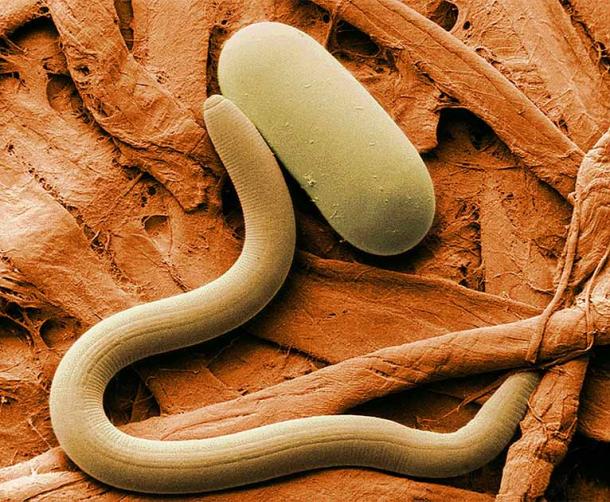
Nematodes that have come to life are perhaps the most incredible living fossils. A colorized electron micrograph of a soybean cyst nematode and egg. (Agricultural Research Service / Public domain )
In his 1863 book History of the Supernatural noted British author and scientist William Hewitt recounted a midsummer incident he had personally witnessed several years earlier in which workmen in Nottinghamshire, England were digging a ditch and unearthed what he called "a regular stratum of frogs." The creatures were not only alive, but so animated they all hopped away.
- New Evidence Suggests Early Humans HIBERNATED In Caves, Like Bears
- Island in the Clouds: Is Mount Roraima Really A ‘Lost World’ Where Dinosaurs May Still Exist?
He described the layer of mud that had held the frogs as "stiff as butter," and based on the time of year and his examination of the ground where they were buried, he estimated they had been there at least six months. As he asked his readers, "If these frogs could live six months in this nearly solid casing of viscous mud, why not six or any number of years?"
Ubelaker expands upon this premise:
"An interesting fact of life is that an organism's structure and composition can remain virtually the same even though it continuously takes in nutrients and produces wastes. Often defined as a dynamic equilibrium, life allows concentrations of the mixture of the materials in an organism to remain constant even though individual molecules are constantly shifting back and forth, increasing or decreasing in a short time scale," he says. "Remember that an organism at equilibrium is dead. A common classroom comparison is often made with a river and the steady state condition of organisms--the river maintains the same level and shape even though water is constantly flowing through it. Rivers rise and change course, drop to low levels depending on the available water, but at any one point it (and its concentration of materials) remains quite constant. In organisms the structure, proteins, nucleic acid, lipids stay relatively constant even though no one molecule remains in any pool for long."
The erratic and odd sides of the natural world remind us of how much we still have to learn about Mother Earth and the processes that govern her and her multitude of children. There are doubtless many more living relics of the primordial past awaiting exhumation. When they do come to light, they should be studied meticulously in order to ascertain how they survived such extremes of time, temperature and deprivation. The possibility of harmlessly subjecting human beings to suspended animation could solve problems of surviving extended space travel, awaiting the return of loved ones from the stars, outlasting terminal illnesses until cures are discovered, or simply staying alive long enough to meet one's great-great-great-grandchildren. Before we can even start on such grand aspirations, however, we must admit this potentially priceless process exists.
Top image: Frog brooch of amber and bronze on a rock, representative of living fossils. Source: ISliM / Adobe Stock
By Kelly Bell
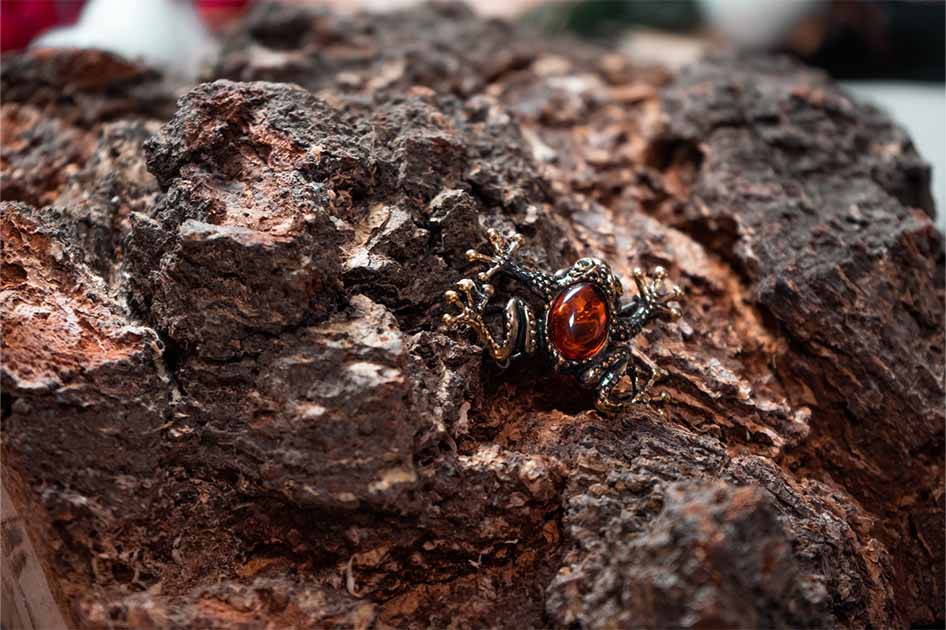
No comments:
Post a Comment